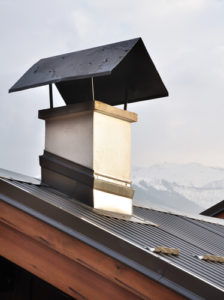How Your Chimney Cap Should Function
The cap may be the most important part of the chimney system-especially in springtime. It essentially protects the chimney flue from the top-down. Chimney caps come in varying styles depending on the climate, wind, and more. They also may double as a damper (top-sealing damper) and may even allow bird habitation. Your cap is the hat that protects the flue opening, and it seems, the cap itself wears many “hats”. 
The Cap Keeps the Weather Out
No matter what kind of chimney cap you have on your chimney, it should keep the weather out. The primary job of the chimney cap is to prevent precipitation from going into the flue. Most caps are designed to let the water run directly off the cap, and onto the crown where it runs off and onto the flashing and roof. These parts of the chimney system work together to prevent water damage that can devastate a chimney.
If you live in an area with high winds such as in a hurricane area, or near the Great Lakes you may find that most chimney caps have wind deflectors. These not only keep water out, but also wind that may carry water, may affect the draft, and more.
The Cap Keeps Animals Out
If a critter can climb onto your roof, you can bet it can also get into your chimney flue if it isn’t capped. Your chimney cap should prevent animal intrusion, including small types of birds, chipmunks, and even larger ones like raccoons. Chimney caps keep even the smallest animals from sheltering in your chimney, bringing their nesting materials, and leaving behind flammable debris and droppings. If you have an animal in your flue, you may need to call a professional for a humane removal. Even if the animal gets out of the flue on its own, it likely left behind claw marks, droppings, feathers, fur, and other materials that do not belong. You’ll need a chimney sweep to clean this material away-and you’ll need a chimney cap installed!
In some cases, like when a chimney swift is allowed into your chimney, there isn’t a thing you can do to remove them. Chimney swifts are federally protected, and they nest in chimneys (the next best thing to hollow trees, which is their natural habitat). These tiny birds will nest in an uncapped chimney and cannot be removed or harmed until they leave on their own, which can take up to 90 days! It’s best to prevent them from arriving in the first place.
The Cap Keeps the Fire In
Finally, your chimney cap will prevent stray sparks from escaping the flue and igniting other materials. Most roofs have dried leaves and branches, and shrubs and grasses are dry from a long winter and may be flammable. The chimney cap sends these sparks right back down to the fire, preventing a possible devastating fire.
Does your chimney have a cap? You’d be surprised how many new homeowners find their chimney without a cap. Others may not have noticed the cap blown off or damaged during winter. Make sure your chimney is capped by looking it over regularly.
Call Chief Chimney Services for more information about repairs and installations of caps and more.

